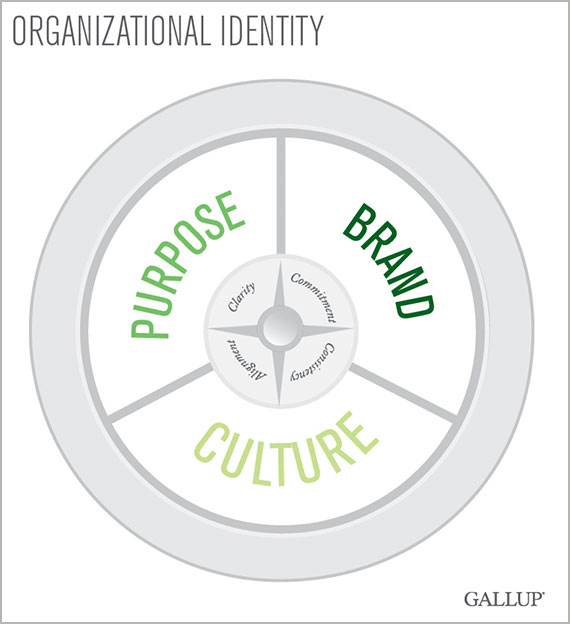Story Highlights
- Companies struggle to connect stated purposes with actions
- Operating with a clear purpose creates a competitive advantage
- Sometimes companies must give up short-term gains
This is the first article in a two-part series exploring organizational identity.
A company's purpose is more than a mission statement or a vision cast from the C-suite. In fact, Gallup finds that when it comes to communicating an organization's purpose to your employees, customers and stakeholders, words don't matter nearly as much as actions do.
At its core, a company's purpose is a bold affirmation of its reason for being in business. It conveys what the organization stands for in historical, ethical, emotional and practical terms. No matter how it's communicated to employees and customers, a company's purpose is the driving force that enables a company to define its true brand and create its desired culture.
However, leaders face an ongoing challenge to make that purpose real, and this starts with their employees. When studying the importance of purpose alongside brand and culture -- the interrelated elements that form an organization's identity -- Gallup often finds dissonance between what companies desire their purpose to be and the brand and culture their employees create through their actions.

Only about one-third of the U.S. workforce strongly agrees that the mission or purpose of their company makes them feel their job is important, Gallup finds. In the hospitality industry, a Gallup Panel survey finds just 28% of employees strongly agree with the statement "I know what my company stands for and what makes our brand(s) different from our competitors."
These findings suggest that organizations are struggling to develop strong connections between their stated purpose and the brand aspirations and workplace culture they create for their employees. And misalignment is costly; Gallup research at a client organization indicates employees who are more aligned with their company's identity perform higher on key business performance metrics than do employees who are less aligned.
An organization's purpose also affects its ability to ensure that it delivers on its brand promise and develops highly engaged customers. Companies build, nurture and grow thriving brands based on strong, clearly articulated purposes. When disconnects arise between a company's aspirational culture and its actual culture, customers experience incongruity between the company's brand promise and its brand behavior.
However, when promise and behavior are in sync and customers are aligned with a brand promise, they give that brand twice as much share of wallet (47%) as customers who aren't aligned with that same brand (23%). Establishing and operating from an anchor of purpose can create a competitive advantage: A company's competitors might be able to replicate products and services, but that company can successfully differentiate itself from the rest by hiring and engaging employees who can fulfill and deliver its purpose and brand in the marketplace.
Demonstrating Purpose Through What a Company Decides Not to Do
One of the most powerful ways to bring a company's purpose to life is to allow it to steer crucial decisions. Strategic decisions are commonly made based on data and projections, but an organization's purpose provides a consistent guide for those decisions over the long term. In many cases, short-term decisions may conflict with a company's purpose and its long-term strategic goals. Establishing and positioning a company for long-term success sometimes requires giving up short-term revenue gains that don't align with its purpose.
Three examples:
- Southwest Airlines has consistently decided against charging customers for checked bags. Sure, the airline would gain an immediate windfall by levying such a fee. But the airline's stated purpose is "To connect People to what's important in their lives through friendly, reliable, and low-cost air travel." Choosing not to charge a customer for her first two pieces of luggage is consistent with this purpose -- and the company differentiates itself and demonstrates its commitment to that purpose in its national advertising campaign, "Bags Fly Free."
- CVS decided to discontinue the sale of tobacco products at its U.S. retail locations and leave billions of dollars in revenue on the table. At the time, the company's CEO said, "Put simply, the sale of tobacco products is inconsistent with our purpose," which the pharmacy steadfastly describes as helping people on their path to better health. In a crowded market, CVS' decision to put purpose ahead of profit could have been costly. But a Gallup Panel study found that, while 51% of consumers were neither more nor less likely to shop the brand because of the company's decision, five times as many consumers said they were more likely to shop the brand (25%) than not (5%). CVS reinforced its purpose by choosing not to continue selling cigarettes, which in turn gave it an opportunity to win new business. And the company remains committed to the decision, recently resigning its membership in the U.S. Chamber of Commerce to avoid a conflict with its purpose to "help people on their path to better health."
- A large regional bank reversed its policy of charging customers for debit cards. The fee was relatively small; in fact, the bank waived the charge when customers met certain balance and deposit minimums. Unintentionally, though, customers with lesser financial wherewithal typically ended up incurring the fee. Charging this customer segment a fee was counter to the bank's purpose, which centered on creating strong financial well-being for its customers. The bank's employees shared their observations with the company's leaders, who then decided to discontinue the fee completely, a choice that clearly communicated to customers and employees that the bank was committed to its stated purpose.
These companies demonstrate a strong commitment to purpose, which is one of four key elements necessary to build strong organizational identity (the others are clarity, alignment and consistency). Though most leaders can readily discuss their organization's ideal identity, they often struggle with making the strategic decisions that reinforce the organization's commitment to its purpose.
Leaders confront the challenge of living up to their company's purpose with every decision they make. In some cases, companies show the strongest commitment to their purpose by walking away from short-term gains that are inconsistent with their stated purpose. These decisions offer opportunities to strengthen an organization's identity with current and potential customers.
The second article in this series covers the five questions companies must ask to create a strong organizational identity.


